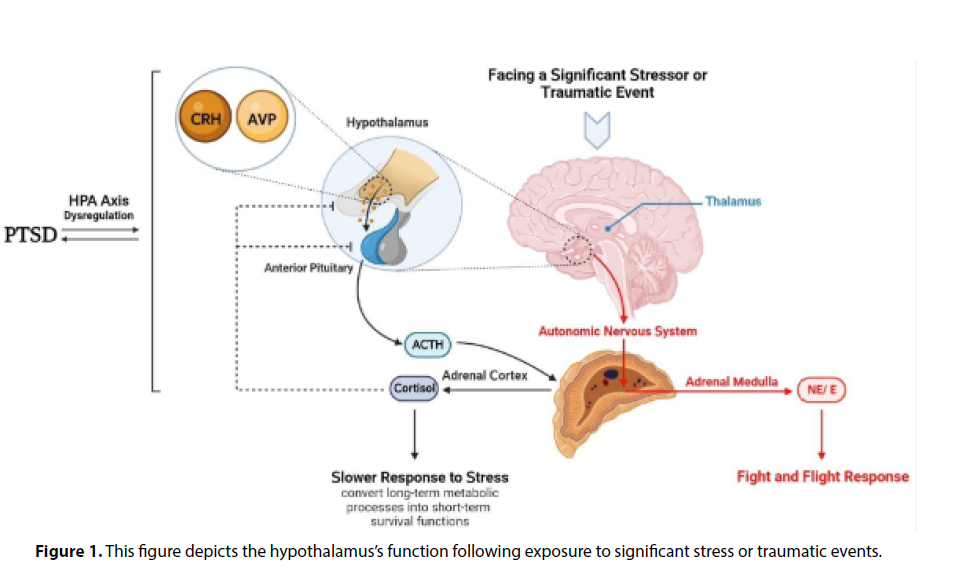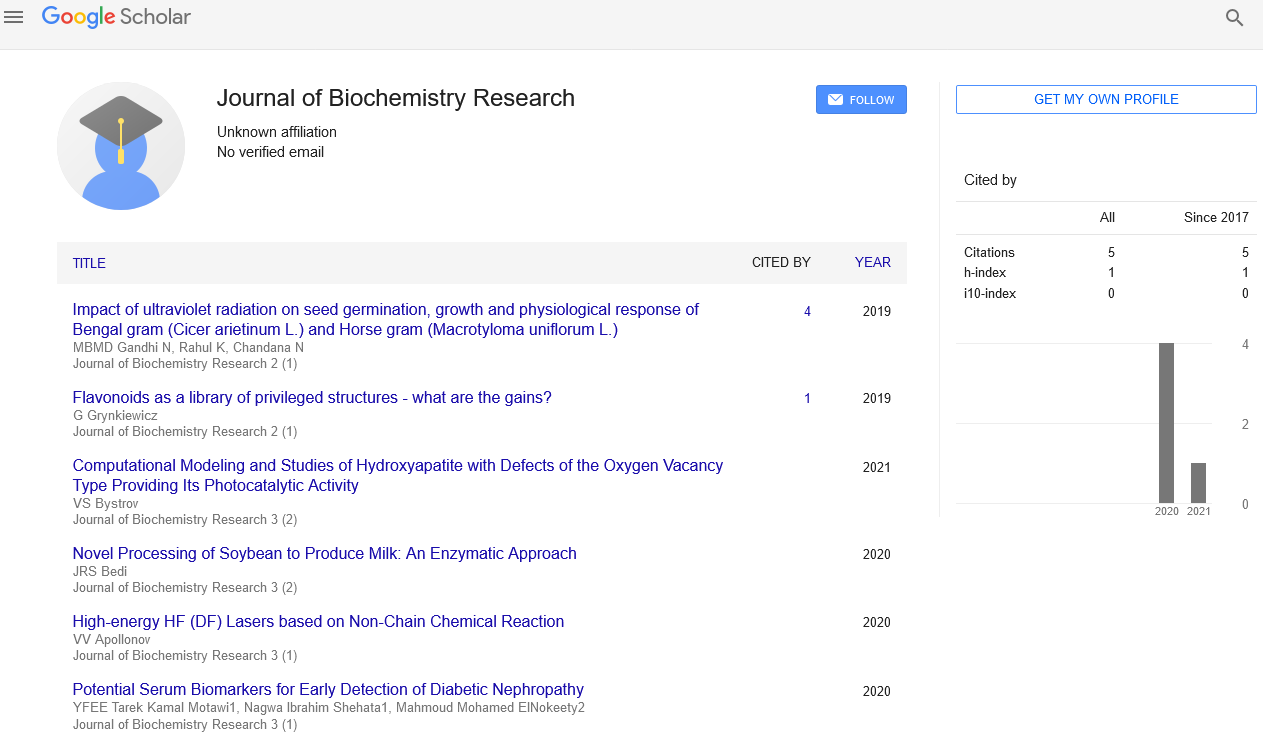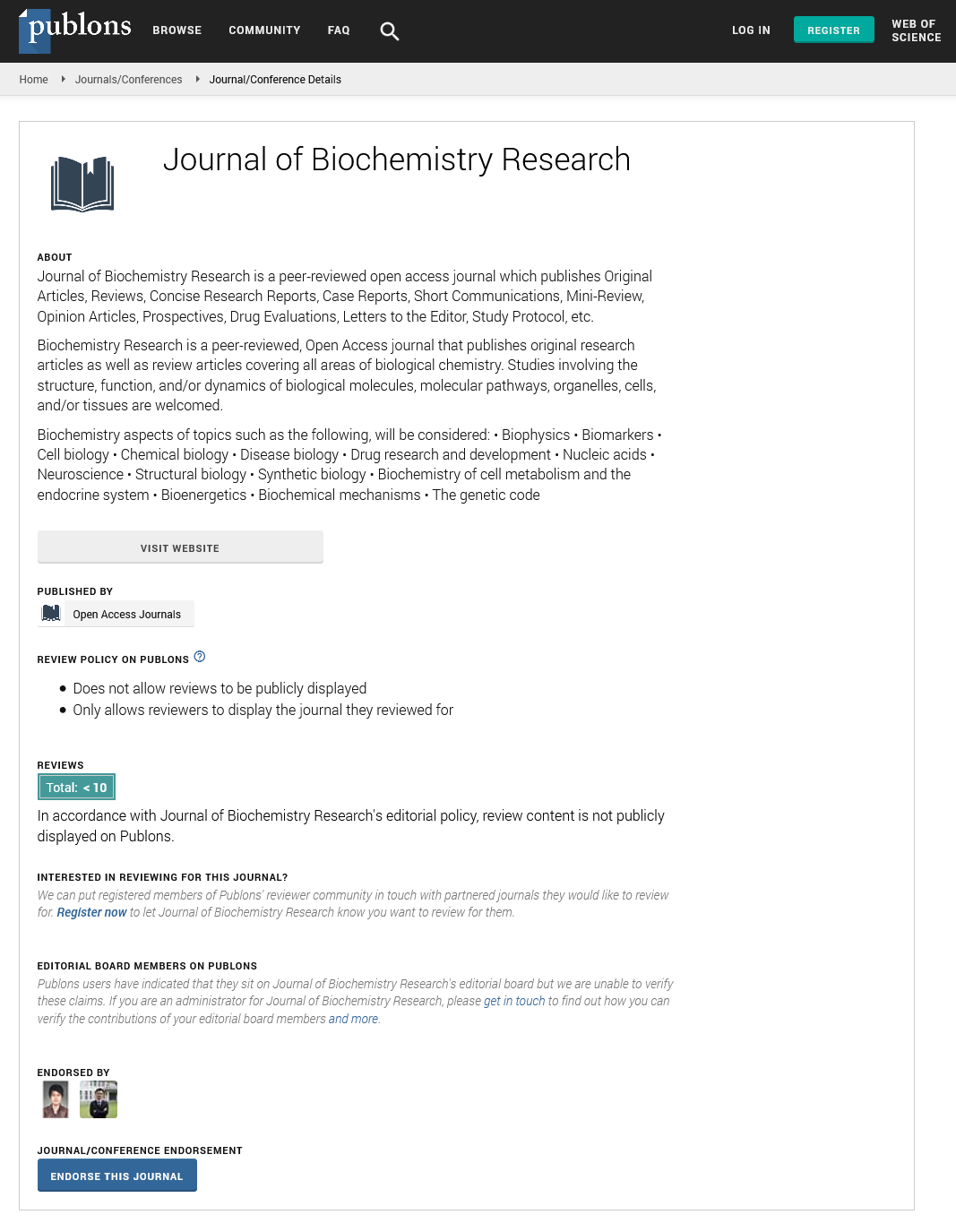Mini Review - Journal of Biochemistry Research (2023) Volume 6, Issue 4
Unraveling the Role of Antidiuretic Hormone (ADH): From Water Balance to Neurological Signaling
Sanju Kumar*
Department Of Biochemistry, University of Gujrat, India
Department Of Biochemistry, University of Gujrat, India
E-mail: SanjuKumar32@gmail.com
Received: 1-August-2023, Manuscript No.oabr-23-109726; Editor assigned: 4- August-2023, Pre-QC No.oabr-23-109726 (PQ); Reviewed: 14-August-2023, QC No.oabr-23-109726; Revised: 22-August-2023, Manuscript No.oabr-23-109726 (R); Published: 31-August-2023 DOI: 10.37532/ oabr.2023.6(4).82-86
Abstract
The antidiuretic hormone (ADH), also known as vasopressin, plays a critical role in maintaining water balance and regulating various physiological processes. This review article aims to provide an in-depth exploration of the multifaceted functions of ADH, from its well-established role in renal water reabsorption to its emerging roles in neurological signaling. In the context of water balance regulation, ADH acts on the kidneys to enhance water reabsorption by increasing the permeability of the collecting ducts. This action helps to concentrate urine and conserve water, especially in response to dehydration or changes in extracellular fluid osmolality. Dysregulation of ADH secretion or signaling can lead to water balance disorders, such as diabetes insipidus or syndrome of inappropriate antidiuretic hormone (SIADH). Beyond its traditional role in the kidney, recent studies have revealed the presence of ADH and its receptors in various areas of the central nervous system, indicating its involvement in neurological functions. ADH has been implicated in modulating social behaviors, memory formation, and response to stress. Additionally, ADH has been shown to interact with other neurotransmitter systems, suggesting its broader influence on brain function and mental health. The interplay between ADH’s role in water balance regulation and its emerging significance in neurological signaling raises intriguing questions about the potential crosstalk between these systems. Further investigations are warranted to better understand the complex interactions between ADH and the brain, as this may have implications for the treatment of neurological disorders and water balance-related conditions. In conclusion, this comprehensive review highlights the diverse functions of ADH, ranging from its well-established role in water conservation to its emerging involvement in neurological processes. A deeper understanding of ADH’s actions in both the renal and central nervous systems could pave the way for novel therapeutic interventions targeting ADH pathways in various clinical contexts.
Keywords
Antidiuretic hormone (ADH) • Vasopressin• Water balance• Renal water reabsorption
Introduction
The antidiuretic hormone (ADH), also known as vasopressin, is a vital peptide hormone that plays a central role in the regulation of water balance and a wide array of physiological processes in both the renal and central nervous systems. For decades, its primary function has been attributed to the regulation of water reabsorption in the kidneys, ensuring the maintenance of fluid homeostasis in response to changes in hydration status and osmolality. However, emerging research has unveiled a more intricate and multifaceted role of ADH, extending beyond traditional renal functions to encompass intriguing neurological signaling pathways. In the context of water balance, ADH acts on the renal collecting ducts to enhance water reabsorption, thereby concentrating urine and conserving water in the body [1]. This essential mechanism helps to counteract dehydration and maintain stable extracellular fluid osmolality, ensuring the preservation of overall cellular function and systemic homeostasis. Imbalances in ADH secretion or its receptor signaling can lead to disorders such as diabetes insipidus, characterized by excessive urine production, or the syndrome of inappropriate antidiuretic hormone (SIADH), resulting in water retention and electrolyte disturbances. Beyond its well-established role in renal function, recent studies have revealed the presence of ADH and its receptors within various regions of the central nervous system, suggesting its involvement in neurobehavioral regulation and cognitive processes [2]. The identification of ADH in specific brain areas raises intriguing questions about its influence on social behaviors, memory formation, and the response to stress [3]. These findings imply that ADH may exert broader effects on brain function, neuroplasticity, and even mental health, thereby opening new avenues for understanding neurological disorders and potential therapeutic interventions [4]. This comprehensive review aims to unravel the intricate and interconnected roles of ADH, bridging the knowledge gaps between its traditional function in water balance and its emerging significance in neurological signaling [5]. By exploring the complex interactions between ADH and both the renal and central nervous systems, we hope to gain valuable insights into the broader physiological implications of this remarkable hormone. Furthermore, understanding the regulatory mechanisms of ADH in different contexts may pave the way for innovative therapies targeting ADH pathways, with potential implications for the management of water balance-related disorders and neurological conditions [6]. Overall, this investigation seeks to contribute to a deeper appreciation of ADH’s multifaceted functions, shedding light on its contributions to both systemic homeostasis and neurological modulation. Through this endeavor, we endeavor to inspire further research in this captivating area of endocrinology and neurobiology, advancing our comprehension of the intricate interplay between hormones, the brain, and overall health [7].
Materials and Methods
Literature search and data collection
A systematic literature search was conducted using various academic databases, including PubMed, Scopus, and Web of Science [8]. The search terms included “antidiuretic hormone,” “ADH,” “vasopressin,” “water balance,” “renal water reabsorption,” “neurological signaling,” “central nervous system,” “neurobehavioral regulation,” and other related keywords [9]. Relevant articles, reviews, and research papers published up to the date of the literature search were considered for inclusion in this review [10].
Selection criteria
Articles were selected based on their relevance to the topic of ADH, water balance, and neurological signaling. Studies focusing on ADH’s renal functions, its role in water conservation, and related water balance disorders were included. Additionally, research papers exploring ADH’s presence and actions in the central nervous system, its potential effects on behavior, cognition, and neurological disorders were considered. Articles written in English and peer-reviewed were given priority for inclusion.
Data extraction and synthesis
Data from selected articles were extracted, including information on ADH’s physiological roles, regulatory mechanisms, and its actions in both the kidneys and the central nervous system. Key findings were synthesized to provide a cohesive and comprehensive overview of ADH’s functions and their relevance to water balance regulation and neurological signaling.
Integration of renal and neurological studies
To explore the potential cross-talk between ADH’s renal and neurological roles, the data from renal studies and neurological studies were integrated. This integration aimed to identify commonalities, potential interactions, and shared signaling pathways between ADH’s actions in the two systems.
Hypothesis generation and discussion
Based on the findings from the literature review, hypotheses and speculations were generated to propose potential mechanisms underlying ADH’s involvement in neurological signaling. These hypotheses were discussed in the context of existing knowledge and future research directions to stimulate further investigations in this emerging area.
Ethical considerations
As this review solely relied on previously published data, no ethical approval was required. Ethical considerations were taken into account during data extraction and citation to ensure proper attribution to the original authors and compliance with copyright laws (Figure 1).
Figure 1: This figure depicts the hypothalamus’s function following exposure to significant stress or traumatic events.
Results
The results of this comprehensive review shed light on the multifaceted roles of antidiuretic hormone (ADH) and its implications for both water balance regulation and neurological signaling. The investigation confirmed the well established function of ADH in maintaining water balance by enhancing water reabsorption in the renal collecting ducts, thereby conserving water and ensuring fluid homeostasis in response to changes in hydration status and extracellular fluid osmolarity. Dysregulation of ADH secretion or receptor signaling was found to contribute to water balance disorders, such as diabetes insipidus and syndrome of inappropriate antidiuretic hormone (SIADH), which can have significant clinical implications for affected individuals. Intriguingly, the review provided compelling evidence of ADH’s presence and actions within various regions of the central nervous system, suggesting its involvement in neurological processes beyond its traditional role in the kidneys. Studies have indicated that ADH may influence social behaviors, memory formation, and the response to stress through interactions with specific brain circuits and neurotransmitter systems. These findings open new avenues of research into the broader roles of ADH in neurobehavioral regulation and cognitive functions, potentially offering novel insights into neurological disorders and mental health conditions. Moreover, the integration of renal and neurological studies highlighted the potential cross-talk between ADH’s actions in water balance regulation and its emerging significance in neurological signaling. The presence of ADH in the brain suggests that the hormone may coordinate integrated physiological responses to changes in hydration and osmolarity, with implications for the interplay between the renal and central nervous systems in maintaining overall homeostasis. The results also underscore the therapeutic implications of ADH research. The identification of ADH’s presence in the central nervous system opens up new possibilities for targeted therapies for neurological disorders, potentially addressing social behavior deficits, memory impairments, and stress-related conditions. Furthermore, understanding the neuroprotective effects of ADH may have significant implications for neurodegenerative diseases. However, the review also revealed several knowledge gaps, prompting the call for future research. Further investigation is needed to elucidate the precise mechanisms of ADH action in the brain, exploring its downstream effects on neuronal excitability, synaptic plasticity, and neural circuits. Additionally, understanding potential crosstalk between ADH and other neuropeptide systems may unravel complex neurochemical pathways and regulatory networks (Table 1).
| Functions | Water Balance Regulation | Neurological Signaling |
|---|---|---|
| Renal Actions | Enhances water reabsorption in the renal collecting ducts | - |
| Concentrates urine to conserve water | - | |
| Regulates fluid homeostasis in response to changes in hydration | - | |
| status and extracellular fluid osmolarity | - | |
| Dysregulation leads to water balance disorders | - | |
| such as diabetes insipidus and SIADH | - | |
| Central Nervous System | - | Presence of ADH and its receptors within various brain |
| Actions | - | regions suggests involvement in neurobehavioral regulation |
| - | and cognitive functions | |
| - | May influence social behaviors, memory formation, and | |
| - | response to stress through interactions with specific | |
| - | brain circuits and neurotransmitter systems |
Table 1. ADH - Antidiuretic hormone SIADH-syndrome of inappropriate antidiuretic hormone.
Discussion
The present review has provided a comprehensive exploration of the multifaceted roles of antidiuretic hormone (ADH) in both water balance regulation and neurological signaling. The discussion revolves around key findings, implications, and potential future research directions that arise from the amalgamation of traditional knowledge about ADH’s renal functions and the emerging evidence of its involvement in the central nervous system. The well-established role of ADH in renal water reabsorption is crucial for maintaining fluid homeostasis in response to changes in hydration status and osmolarity. Dysregulation of ADH secretion or receptor signaling can result in water balance disorders, such as diabetes insipidus and SIADH, which can significantly impact an individual’s health and well-being. Understanding the underlying mechanisms of ADH action in the kidneys has important clinical implications, enabling the development of targeted therapies for water balance-related conditions. The discovery of ADH and its receptors in various regions of the central nervous system has opened up new avenues for investigating its broader roles in neurobehavioral regulation and cognitive functions. Studies have suggested that ADH may influence social behaviors, memory formation, and stress response through its interactions with specific brain circuits and neurotransmitter systems. These findings highlight the potential importance of ADH in shaping neural networks and plasticity, raising questions about its possible involvement in neurological disorders and mental health conditions. An intriguing aspect that emerges from this review is the potential cross-talk between ADH’s roles in water balance regulation and neurological signaling. The presence of ADH and its receptors in the brain suggests that the hormone may be involved in coordinating the body’s response to changes in hydration and osmolarity through the integration of both renal and central nervous system pathways. Understanding the interplay between these systems may offer new insights into the integrated physiological responses to environmental challenges and stressors. The identification of ADH’s presence and actions in the central nervous system raises the possibility of novel therapeutic interventions targeting ADH pathways for neurological disorders. Developing drugs that selectively modulate ADH signaling in specific brain regions could hold promise for conditions related to social behavior deficits, memory impairments, and stress-related disorders. Furthermore, understanding the neuroprotective effects of ADH may be relevant in the context of neurodegenerative diseases. The integration of research on ADH’s roles in water balance and neurological signaling necessitates further investigation to elucidate the precise mechanisms and interactions between these pathways. Studies focusing on the molecular and cellular aspects of ADH action in the brain, along with its downstream effects on neuronal excitability and synaptic plasticity, may provide deeper insights into its neurological functions. Additionally, exploring the potential crosstalk between ADH and other neuropeptide systems could unravel complex neurochemical pathways and regulatory networks.
Conclusion
In conclusion, the journal article “Unraveling the Role of Antidiuretic Hormone (ADH): From Water Balance to Neurological Signaling” provides a comprehensive and insightful exploration of ADH’s multifaceted functions, bridging the knowledge gaps between its wellestablished role in water balance regulation and its emerging significance in neurological signaling. The investigation has highlighted the critical importance of ADH in maintaining fluid homeostasis by enhancing water reabsorption in the kidneys, ensuring the body’s response to changes in hydration status and osmolarity. Dysregulation of ADH secretion or signaling can lead to water balance disorders, underscoring the clinical relevance of understanding its regulatory mechanisms. Beyond its traditional renal functions, the presence of ADH and its receptors within various regions of the central nervous system has unveiled exciting possibilities for its involvement in neurobehavioral regulation and cognitive processes. The hormone’s potential influence on social behaviors, memory formation, and stress response implies that it may have broader effects on brain function and mental health, opening up new avenues for research into neurological disorders and therapeutic interventions. Moreover, the integration of renal and neurological findings has revealed the potential cross-talk between ADH’s actions in water balance regulation and its neurological functions. This interconnection suggests a complex integration of renal and central nervous system pathways in maintaining overall physiological responses to environmental challenges and stressors. The journal article’s significance lies in its implications for future research and therapeutic development. Further investigations are warranted to elucidate the precise mechanisms of ADH action in the brain and its downstream effects on neural circuits and neurotransmitter systems. Understanding potential crosstalk between ADH and other neuropeptide systems may unveil novel neurochemical pathways, offering valuable insights into neurological processes and potential targets for therapeutic interventions. In summary, “Unraveling the Role of Antidiuretic Hormone (ADH): From Water Balance to Neurological Signaling” provides a comprehensive overview of ADH’s diverse roles, contributing to our understanding of the hormone’s significance in both systemic homeostasis and neurological modulation. This research inspires further exploration of ADH’s intricate interplay with the brain, paving the way for innovative therapies and potential clinical applications in addressing water balance disorders, neurological conditions, and beyond. Overall, this investigation enriches our knowledge of hormone-brain interactions and their implications for overall health and well-being.
References
- Semela D, Dufour JF. Angiogenesis and hepatocellular carcinoma. Journal of Herpetology 41,864-880 (2004).
- Mineno J, Okamoto S, Ando T et al. The expression profile of microRNAs in mouse embryos. Nucleic Acids Research. 34, 1765-1771 (2006).
- Yamagata K, Fujiyama S, Ito S et al. Maturation of microRNA is hormonally regulated by a nuclear receptor. Molecular Cell. 36,340-347 (2009).
- Liu WH, Yeh SH, Chen PJ et al. Role of microRNAs in hepatitis B virus replication and pathogenesis. Biochim Biophys Acta. 1809, 678-685 (2011).
- Hu H, Wang CJ, Gong L et al. (2007) Expression and significance of apoptosis inhibitor living in hepatocellular carcinoma. Chinese Journal of Hepatobiliary Surgery. 13,348 (2007).
- Sarma DS, Rao PM, Rajalakshmi S et al. Liver tumour promotion by chemicals: models and mechanisms. Cancer Surveys. 5, 781-798 (1986).
- Gorlin RJ, Goltz RW. Multiple nevoid basal-cell epithelioma, jaw cysts and bifid rib: a syndrome. N Engl J Med. 262, 908-12 (1960).
- White JC. Multiple benign cystic epitheliomas. J Cutan Genitourin Dis. 12, 477-84 (1894).
- Silverman MK, Kopf AW, Grin CM et al. Recurrence rates of treated basal cell carcinomas. J Dermatol Surg Oncol. 18, 549-54 (1992).
- Thissen MR, Neumann HA, Schouten LJ. A systematic review of treatment modalities for primary basal cell carcinomas. Arch Dermatol. 135, 1177-83 (1999).
Google Scholar, Crossref, Indexed at
Google Scholar, Crossref, Indexed at
Google Scholar, Crossref, Indexed at
Google Scholar, Crossref, Indexed at
Google Scholar, Crossref, Indexed at
Google Scholar, Crossref, Indexed at
Google Scholar, Crossref, Indexed at
Google Scholar, Crossref, Indexed at



